How to choose a convection heater: comparative review and recommendations before purchasing
Convectors are safe, durable and reliable heating devices. Thanks to a wide range, ease of use and varied designs, their popularity is steadily growing.But not all units are equally good and functional.
We will tell you how to choose a convection heater that fully meets your needs. The article presented for review describes all types of devices, the principles of their operation and design features. Their strengths and weaknesses are analyzed and recommendations for use are given.
The content of the article:
Design and principle of operation of the equipment
Having all the necessary information about devices with the convector heating principle, making a purchase will be much easier.
The main structural elements of the device are the housing, the heating element (heat exchanger) and the thermostat with a regulator located on the external panel. Many convectors are “equipped” with various additional features to increase the comfort and safety of device operation.
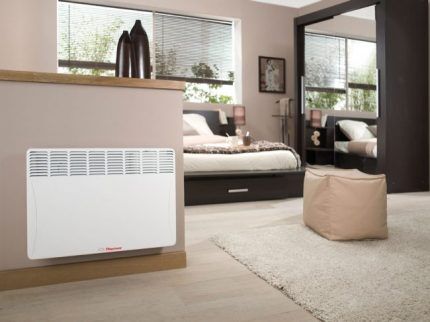
The functioning of the devices is based on the process of natural air circulation - convection.Cold air enters the convector body, where, upon contact with the heating element, it quickly heats up and rushes upward.
Basic physics: warm air is lighter than cold air. Having cooled down, it falls down and enters the heater again - and the cycle repeats.
Thus, thanks to convection, warm air masses constantly circulate in the rooms and a comfortable temperature is maintained. This operating principle allows the equipment to heat the air not only efficiently, but also as uniformly as possible.
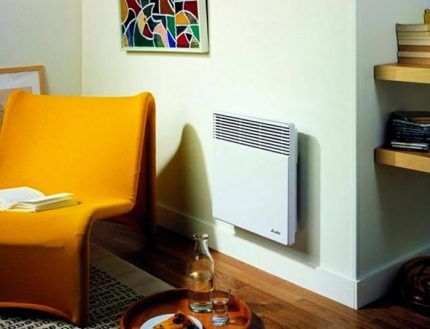
What types of convectors are there?
Depending on the energy source, there are:
- electrical;
- water;
- gas convectors.
The most practical gas appliances, but electric convectors are the most in demand. Even the most advanced models of equipment, equipped with a maximum of additional functions, are usually cheaper than water and gas heaters.
According to the method of installation of the device there are:
- floor-mounted;
- wall-mounted;
- baseboards;
- built-in (in-field, basement).
From the point of view of ease of use, wall-mounted units are the best. Connoisseurs of modern design solutions should pay attention to built-in and baseboard heaters. Electric floor convectors are good for their mobility.
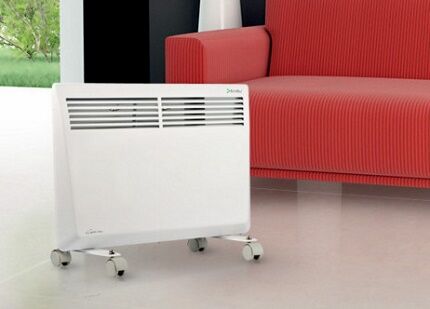
By type of convection:
- with natural convection;
- with forced convection.
Forced convection is provided by a built-in fan. The advantage of its presence in the convector design is faster heating of the air, the disadvantage is noise during operation.
By type of temperature control:
- with mechanical control;
- with electronic control.
Devices with mechanical controls are more familiar and easier to use, while devices with electronic controls are more convenient, but more expensive.
Electric convector and its features
Electric convectors are the easiest way to heat an apartment or house. These devices are compact, have a reasonable price, and demonstrate high efficiency. They have proven themselves well both as additional and main heating for a small house.
Modern devices do not even closely resemble their predecessors with a red-hot coil placed in front of the reflector - they are perfect and safe.
In addition, among the advantages of the equipment:
- ease of maintenance;
- ease of use;
- environmentally friendly heating (does not burn oxygen);
- attractive appearance.
- no need for preparatory work. No projects, permits, or special conditions are needed.
It is enough to calculate the required number of electrical appliances, buy a convector, install it on the wall or floor and plug it into an outlet.
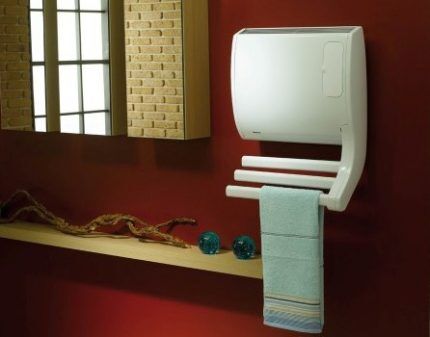
Types of heating elements
The heating element of most electric convectors on the market is tubular. It is a steel tube filled with heat-resistant ceramics or quartz, through which a nichrome thread passes.
Aluminum fins are fixed on the surface of the heating element, providing good heat transfer and enhancing convection.
In general, such heating elements are quite good and reliable. But there are also disadvantages. Aluminum expands when heated more than steel: thus, expanding unequally, the structural components rub against each other during operation and gradually wear out. The heating process of the convector begins to be accompanied by crackling.
Due to the violation of the tight contact between the steel tube and the aluminum fins, heat transfer is difficult, which can lead to local overheating and burnout of the heating element.
The most advanced heaters use low-temperature monolithic heating elements. The filament in them is tightly pressed with ceramic insulators into a solid aluminum (or silumin) housing with fins.
All materials for such a heating element are selected in such a way that their coefficient of thermal expansion is almost the same. This ensures complete silence and maximum durability of the device. The service life of such heating elements can reach 20 years.
As for the efficiency, it is approximately the same for convectors with both one and another type of heating element, so from this point of view you can choose any one.
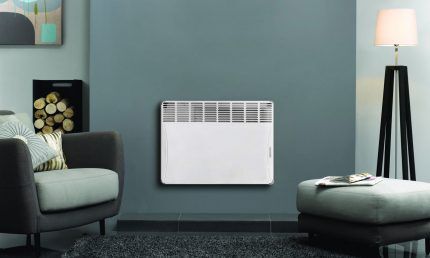
Attention to the device body
When choosing a convector heater, you must pay attention to the aesthetics of the housing - this can say a lot about the quality of the device as a whole. Damage to the paintwork is unacceptable; All corners and seams must be smooth and neat. Low-quality devices can almost always be distinguished from “worthwhile” ones by their appearance.
An important characteristic of electric convectors is the height of the body - the speed of the air flow passing through the heating element depends on it. Convectors with a height of 40-60 cm or more are characterized by a high flow rate due to good draft (as in a chimney pipe: the higher, the stronger).
When the height of the device is 20-40 cm, its length is increased to maintain thermal efficiency. Skirting convectors have a minimum air flow speed, so their length can be very long - up to 2-2.5 m.
There is no particular difference in the efficiency of “high” and “low” electric convectors, since it does not depend on the size of the device, but on its power. Various form factors of equipment are necessary, first of all, to implement devices into any interiors as successfully and effectively as possible.
All electric heaters have a certain protection class (International Protection). It indicates the degree of resistance of the interface to solid particles and moisture.
Basically, convectors have a protection class of IP 20 (no moisture protection), IP 21 (drop protection), IP 24 (splash-proof models).Only devices with IP 24 or higher are suitable for the bathroom.
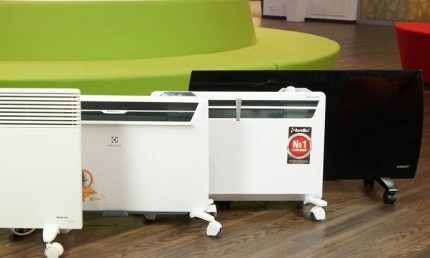
Calculation of required power
The average selection of the power of a convector heater is made according to the following formula: 1 kW of heat per 10 sq. m of room area with a ceiling height of 2.7 m. For higher ceilings, it is recommended to add 10% power for every 10 cm above the indicated figure.
It is advisable to cover each window opening with heat flow, i.e. ideally there should be as many convectors as there are windows in the room. Optimal, from a practical point of view, is a heater that has the same length as the width of the window. A wide heat flow with good speed is a reliable “curtain” that effectively maintains the temperature balance in the room.

To determine the required power of the convector more accurately, you need to make a calculation based on the volume of the room - 35-40 W of heat per 1 cubic meter. m. In this case, heat loss must be taken into account.
For corner rooms, rooms with panoramic windows, rooms “adjacent” to a basement or attic, it is highly advisable to select equipment with a good power reserve. This will help speed up the heating of the air to the set temperature.
The danger of buying a device with insufficient power is that it will not be able to reach the desired temperature and will work non-stop.
Criteria choosing an electric convector This article is devoted to the contents of which we recommend that you familiarize yourself with it.
Where to place the electric convector?
Depending on the installation method, there are wall-mounted, floor-mounted and baseboard electric convectors. Devices for stationary wall installation can be hung on brackets in any convenient place (optimally under a window), they are compact and aesthetically pleasing, and do not create obstacles when moving around the room.
Floor-standing devices, thanks to their “legs” (with or without wheels), are mobile; within the range of the power cord, they can be freely moved around the room, as well as transferred to other rooms.
It is worth noting that almost all models of electric convectors are universal, i.e. You can install them both on the floor and on the wall, periodically changing the location if desired. Even if the set does not include legs, they can always be purchased separately.
Baseboard heaters are installed close to the floor along the walls. Thanks to their compact size and special placement, they can be successfully integrated into any interior and do not create obstacles for the installation of furniture.
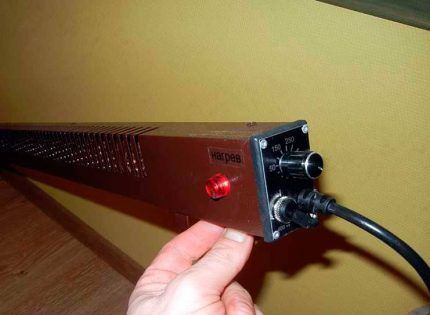
Important operational details
Along with an impressive list of advantages of electric convectors, they also have certain disadvantages. The first and main disadvantage of the equipment is its absolute dependence on the availability of electricity in the network. Once the voltage drops, the convector becomes an absolutely useless piece of hardware.
Due to the fact that power outages remain commonplace in many regions, using them as the main heating system is not always convenient. But as an additional source of heating, they are very good - they are appreciated by both residents of high-rise buildings and owners of country houses.
Despite the constant improvement of the design of convectors, their energy consumption is still very high. When heating a large apartment or home, electricity bills can be daunting.
Installation electric heaters imposes certain requirements on the quality of wiring. It is naive to believe that “Soviet communications” will withstand the “appetites” of modern equipment.
To create an autonomous heating system based on convectors, it is necessary to lay a separate power supply line. Despite the apparent difficulties, it is always cheaper and easier than installing a boiler and laying pipes.
Rational solution: gas convector
Gas convectors operate on natural (main) or liquefied (cylinder) gas. They do not require a power source, with the exception of those models that are equipped with a fan to improve air circulation.
But even without electricity, such devices work quietly - the fan just doesn’t spin.The units are usually used as the main heating devices, but can also play an auxiliary role.

Advantages and disadvantages of equipment
Among the important advantages of gas convector heaters, in addition to “electronic independence”, it is worth highlighting the following points:
- These devices are not afraid of frost, they can be safely left in unheated houses;
- the products are safe: the gas supply is automatically stopped in a critical situation.
A significant advantage lies in the simplicity of the device, due to which the devices are quite reliable and boast high efficiency.
The equipment also has disadvantages:
- Despite their small dimensions, gas convectors are usually difficult to successfully fit into the interior;
- you need to “hollow” the wall for a coaxial gas outlet.
A significant disadvantage is that you cannot simply pick up a gas unit and “move” the device to another location.
Gas convector design
The gas heater consists of the following components:
- Metal body. It is coated with heat-resistant paint. At the bottom and top the structure is open for air circulation.
- Finned heat exchanger. Heats the air. The larger it is, the faster the temperature in the room rises.
- Burner. This is where gas is burned.
- Combination valve. Responsible for regulating the flow of gas into the burner.
- Chimney. Removes smoke from the device. Not all manufacturers include a chimney in the delivery package - this is worth paying attention to when choosing equipment.
- Thermostat. Element for controlling the operation of a combination valve.
- Automation. Shut off the gas supply in emergency situations.
Also, the gas convector can be equipped with a fan and remote control (expensive models).
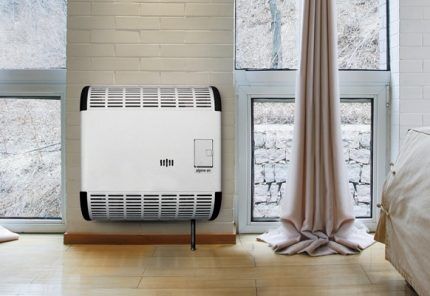
Recommendations for choosing devices
The product must be adapted to the pressure in your gas system. The required power of a gas convector is calculated using the well-known formula - for every 10 sq. m of premises requires 1 kW of heat. It would not be amiss to add 1 kW to the resulting value for poor-quality insulation or old windows.
Depending on the mounting method, the devices can be wall-mounted or floor-mounted. The first ones are lighter and more compact, have sufficient power; It is usually recommended to opt for them.
A very important parameter when choosing a gas heater is the material from which its heat exchanger is made, this can be:
- cast iron;
- aluminum;
- steel.
The cast iron heat exchanger heats up evenly, has a fairly high efficiency, and can operate for half a century.But since cast iron is a brittle material, under certain conditions (for example, a large temperature difference) it can burst. In addition, this design is heavy.
Aluminum heat exchangers have excellent thermal conductivity, but their heat resistance is low. The devices equipped with them are expensive.
A steel heat exchanger is the best option. In a number of characteristics, it is certainly inferior to its “competitors”. But it is durable, light and cheap.
A good bonus in the design of a gas convector is the presence of a fan. It reduces the heating time of the room and reduces the risk of heat exchanger burnout, but increases the cost of the equipment.
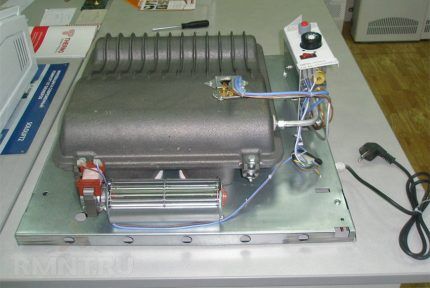
Water convectors: efficient and spectacular
Water-type convectors are modern devices that are an excellent alternative to standard radiators. The devices are successfully used in autonomous heating systems of private houses and apartments, as well as in centralized heating networks. Water convectors reliable, economical and durable, their efficiency is about 95%.
Types of water appliances
Water convector devices are an ideal solution for rooms with a large glass area. Depending on the model, a water convector can be either an independent heating unit or a source of additional heating.
Thanks to various equipment form factors, the heating issue can be solved not only efficiently, but also effectively.
Water convectors are:
- floor;
- wall-mounted;
- baseboards;
- intra-field;
- built-in
All of them take up minimal space, and in the case of hidden installation, they even save usable space.Installation in the wall, floor, steps, or under furniture allows you to save such valuable square meters and provide comfortable heating. In-floor devices with drainage drainage can be successfully used in rooms with swimming pools, greenhouses, winter gardens, etc.
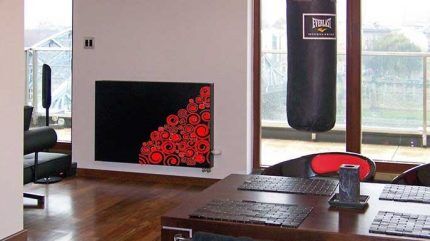
A variety of designs - from laconic classic to bright modern - makes it easy to fit the units into any interior.
Features of various equipment modifications
Water wall convectors are a steel body with a perforated grille located on top, which houses a copper-aluminum heat exchanger. The devices are mounted using a special mounting kit, which is necessarily included in their factory package.
Wall convectors are an excellent choice for rooms that require fast and efficient heating and have enough free space for installation on the wall. This is the most successful solution for children's rooms and bedrooms. They are not suitable for heating solid glazing that extends into the floor.
Floor-standing water convectors are usually installed in rooms with low window sills. It is also possible to install them near panoramic windows if, due to the low height of the screed, it is not possible to install an in-floor unit. In addition to the housing with a heat exchanger, such devices are structurally supplemented with a steel supporting base.
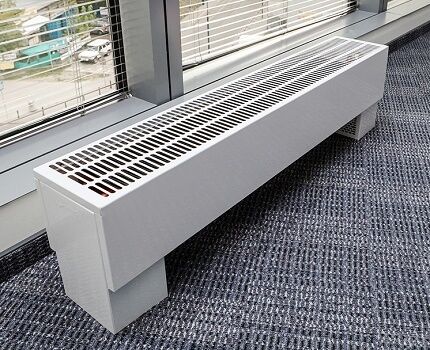
Such convectors somewhat clutter up the space, however, they fit perfectly into rooms with modern interiors in the loft, modern, hi-tech, and avant-garde styles.
Skirting water heating devices are practical and compact.The low thermal intensity of such convectors allows them to be mounted directly next to furniture and various decorative elements. This gives a huge advantage in terms of organizing space.
Structures built into the floor are used to cut off cold air flows coming from windows. The units can effectively solve the problem of condensation on large window glazing (“crying windows”). Built into the floor level, they take up no space at all and do not interfere with enjoying the panoramic view.

Ways to control air temperature
Any modern convector allows you to set the desired temperature in the room. For this purpose, their design includes thermostats. They are mechanical and electronic, plug-in devices and built into equipment.
A mechanical thermostat is simple and cheap; it may have characteristic clicks during operation, but ensures stable operation of the device in conditions of voltage fluctuations. Temperature setting and control must be done manually.
An electronic thermostat provides temperature control using sensors, reacting to its changes automatically. It is absolutely silent. Can be built-in or remote. The smartest controllers can be controlled remotely.
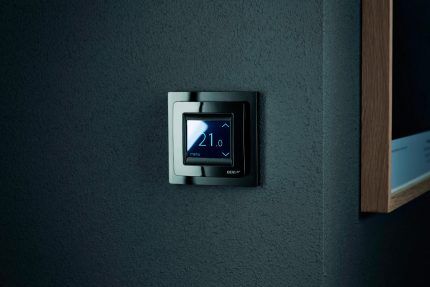
It will help you get a complete understanding of the pros and cons of convectors next article, highlighting the advantages and disadvantages of convector appliances in comparison with fan heaters.
Conclusions and useful video on the topic
Video #1. Tips for choosing an electric convector:
Video #2. Review of one of the simple models of gas convectors:
Deciding which is the best convector heater to buy is certainly not easy. Especially when there is so much choice. For additional temporary heating of rooms, the simplest and most convenient solution is electric models. If gas is supplied to the room and you need constant heating, it is better to choose a gas unit.
Water convectors are characterized by a high price and labor-intensive installation - it makes sense to buy them if you are determined to install a full-fledged heating system and are willing to fork out the cash. And remember: the most important thing is that the chosen device is powerful enough.
Please write comments in the block form below. Tell us about your own experience in choosing a convector, tell us which type you prefer and why. Ask questions, share your opinion and useful information, post photos related to the topic of the article.




New generation electric convectors are safe, practical and economical heaters. Based on our realities of life, they should be in every apartment. Wall-mounted units are ideal for any interior and take up virtually no space. Unlike their predecessors, they do not dry out the air and provide uniform, comfortable heat. I installed baseboard equipment on the loggia - an ideal alternative to a warm floor, but it warms not only the floor, but the entire space.
Water convectors, in my opinion, will be much safer and more harmless. Therefore, I recommend choosing them.